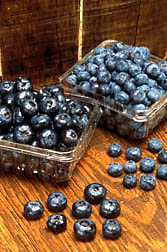Science Update
Ag Waste Takes On Toxic Metals
Agricultural wastes can scavenge toxic metals from industrial waste-water, ARS researchers found. Current removal methods are costly, especially for small and medium-sized businesses. The researchers' new approach is to produce granular-activated carbons, or GAC's, from plentiful ag byproducts. These include hulls of soybeans, cottonseed, and rice. To make GAC's, high heat and steam turn a mix of byproducts—blackstrap molasses plus ground-up hulls—into tiny, pitted granules. A pound of these GAC's has over 100 acres of surface area—lots of room to snare metal particles. In ARS lab tests, the agri-GAC's removed up to 100 percent of the zinc and almost all the copper and nickel from waste-water. That's at least as effective as GAC's made with coal, a nonrenewable resource. Plus, GAC's from ag byproducts may be cheaper to produce. To ready this technology for the electroplating, jewelry, and other industries, ARS formed a CRADA (cooperative R&D agreement) with Z Corp. of Albuquerque, New Mexico.
Wayne E. Marshall, USDA-ARS Environmental Technology Research Unit, New Orleans, Louisiana, phone (504) 286-4356.
ARS and France Agree on Insect Gene Transfer
Medflies and malaria are two targets of a new international research agreement. ARS and France's national agricultural research center (Centre National de la Recherche Scientifique) have begun collaboration to develop reliable gene-transfer methods for insects and other invertebrates, such as oysters. This could speed progress on agriculture, aquaculture, and health objectives important in many countries. Giving mosquitoes genes to keep them from transmitting the parasite that causes malaria might reduce its human death toll—estimated at 2.7 million each year. In June, ARS insect geneticist Alfred M. Handler went to France to work with University of Montpellier insect pathologist Max Bergoin for 4 months. They are using cotton leafworms and Mediterranean fruit flies as experimental models. Medfly gene transfer has several potential uses, such as distinguishing beneficial sterile medflies from destructive fertile ones. Another potential application: freeze tolerance in insects mass-reared for biocontrol. This would allow storing biocontrol insects in "suspended animation" until needed for release. Currently, the insects must be released when they reach the desired life stage.
USDA-ARS International Research Programs, Beltsville, Maryland
Bacteria Dine on Weed Killers
|
|
ARS researchers found a pesticide-gobbling "Mr. Clean" microbe in an unlikely place—municipal sewage sludge. The Klebsiella terragena bacterium may be ideal for breaking down weed-killing chemicals in water rinsed from tractor-pulled spray tanks. That would free farmers from storing contaminated rinse water while searching for an environmentally safe disposal site. Treating the rinse water requires two 55-gallon, cone-shaped tanks. An ozone generator pumps the gas through rinse water in one tank for 12 hours. Then the water is pumped into the second tank, Klebsiella's dining room. In 24 hours, little remains but carbon dioxide and water that farmers can safely dump on the ground. Klebsiella degrades three major herbicides—atrazine, cyanazine, and simazine. Earlier, researchers identified other microbes to break down alachlor, metolachlor, and 2,4-D.
Cathleen Hapeman, USDA-ARS Environmental Chemistry Laboratory, Beltsville, Maryland, phone (301) 504-6451.
New Blueberry Is Pick-Your-Own Bonanza
Chandler, a tasty new ARS blueberry for pick-your-own farms and home gardens, could be at retail nurseries by 1997. Limited numbers of plants should be available to researchers and breeders in 1996. The new highbush variety produces high yields of very large blueberries that ripen slowly and later in the season than Bluecrop, a standard since 1952. These qualities allow harvesting of Chandler over several weeks in July and August. This is a bonus where hands, not machines, do the picking. Chandler plants grow about 5 feet high.
Chad Finn, USDA-ARS Horticultural Crops Research Laboratory, Corvallis, Oregon, phone (503) 750-8759.
"Science Update" was published in the September 1995 issue of Agricultural Research magazine.







